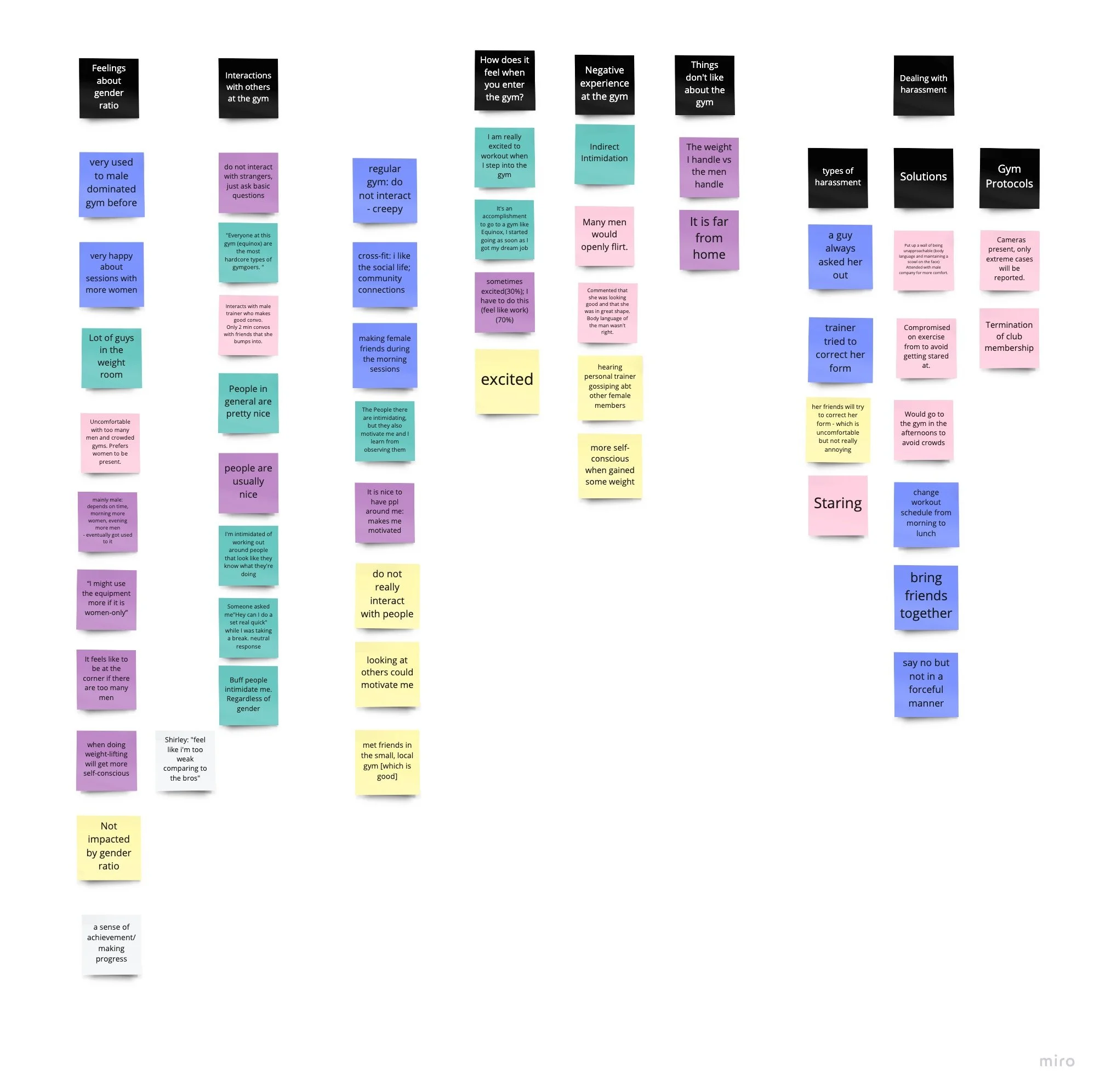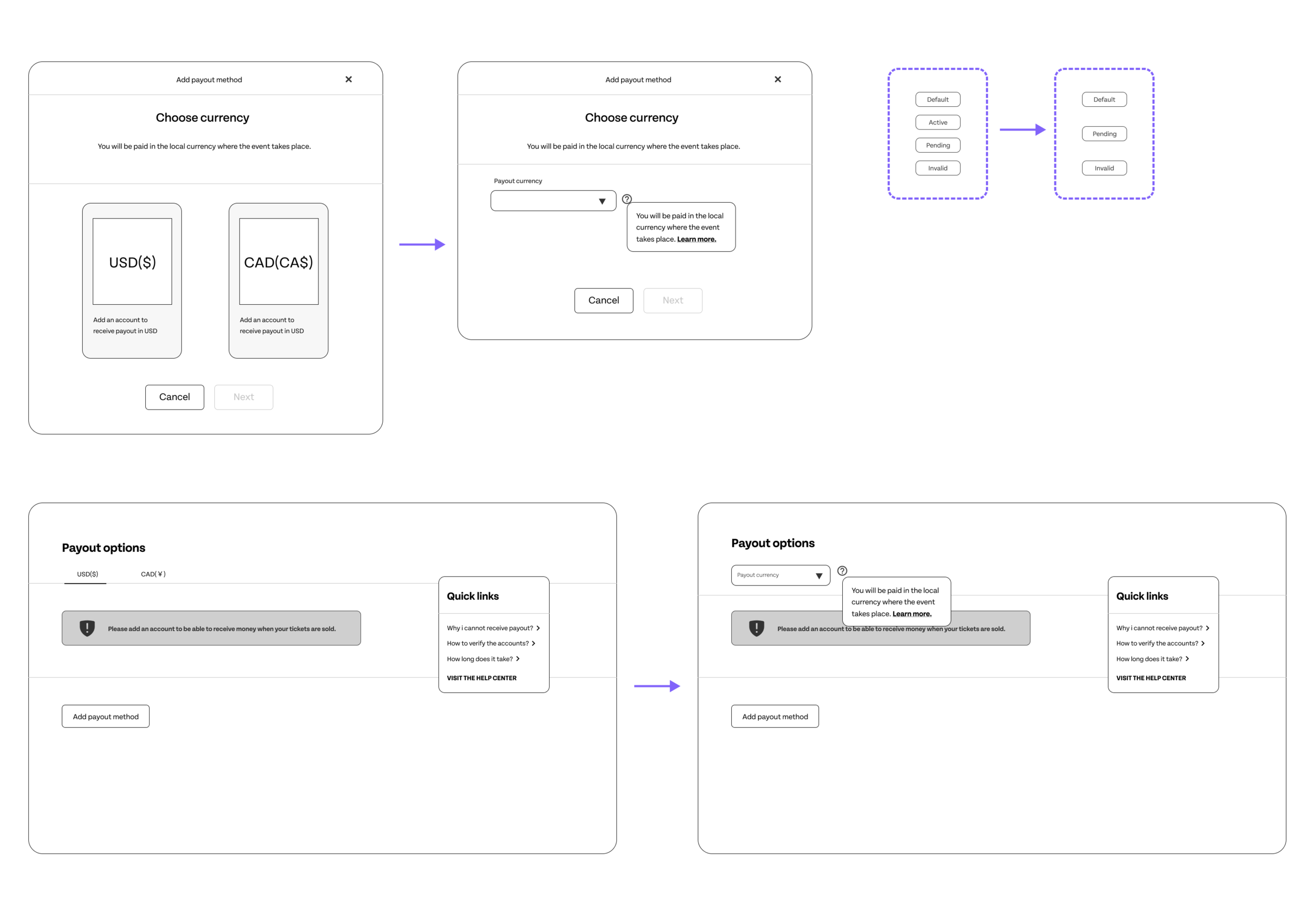Mily
Oct - Dec 2021
Class Project (HCDE 518)
overview
―
Our team designed a gym buddy finder to help women feel welcomed and confident in strength training spaces. On top of finding a gym buddy, people can easily navigate the gym space, learn how to use the equipment, find like-minded groups to work out, and share tips. This helps strengthen the college gym community while empowering women to reap the health benefits of exercising.
project type
User Research
User Experience Design
role
User Researcher
Prototype
Visual Design
duration
8 weeks
team
Lily Liu
Yixi Liu
Ilia Savin
Meghna Balachandran
what was the problem we were trying to solve?
―
“How might we empower young women to use strength training spaces with ease and confidence?”
what were my main responsibilities?
―
Need-finding though primary and secondary research
I conducted desktop research (background analysis and competitive analysis) and lead 6 in-depth user interviews to learn women’s experience at the gyms.
Ideate and prototype based on key insights and goals
I worked with my team to synthesize research findings. We built 3 personas and identified key design goals to prototype low and mid-fidelity designs together.
Design, test, and iterate
I was in charge of building the visual design system and the navigation feature. I tested and iterate the design based on 3 mini-sessions of usability testing sessions.
timeline
―
insights and design opportunities
―
The intransparent payout process causes user confusion
StubHub’s current design hides necessary information on proper payout account set-up Sellers have to learn from their failure. We want to increase transparency so that sellers are informed and able to complete the payout set-up easily.
Little communication on account troubleshooting
StubHub does not provide appropriate feedback on payout account status. It is very difficult for users to understand when and how to fix their accounts. We want to use effective communications and in-hand help to improve the trouble-shooting experience.
Inconsistency and misuse of design elements
Inconsistent UX writings and violations of design conventions create moments of frictions for sellers to smoothly set up and manage their payout accounts. We aim to redesign current design components for an overall frictionless seller experience.
why this project?
―
With many gym enthusiasts in our group, we set out to address some of the main problems of working out in gyms as female students. Our motivation for pursuing this problem space came from conducting secondary research, which proved that sexual harassment and discomfort in gyms disproportionately affected young women.
Stats about female gym members from our secondary research
design goals
―
The success of our solution will be evaluated based on these design goals.
Help women achieve their fitness goals without distraction.
Help women stay safe and feel comfortable at the gym.
Facilitate positive interactions at the gym.
Offer a personalized gym experience for everyone regardless of their experience level.
research methods
―
We used user interviews, field observation, and surveys to generate insights, inform our primary and secondary personas, and guide our future design decisions.
-
Survey (258 responses)
We chose to conduct a survey to answer the research questions of: What forms of discomfort do women experience at gyms? How do women deal with them?
A total of 258 responses were received. Multiple choice or yes or no questions generated pie charts while short answers are analyzed through affinity diagramming.

-
User Interviews (6 semi-structured)
Our team conducted 6 semi-structured qualitative interviews to answer why women change their behaviors at gyms.
Our participants were gym-going women between the ages of 18-35 chosen based on their responses to the screening survey. We also conducted a stakeholder interview with a local gym owner in Seattle. Notes from the interviews were analyzed using affinity mapping and helped breathe life into our personas.

-
Fly on the wall (field observation)
Research Question: How do behaviors and interactions vary with respect to gender within gym spaces?
Independent observations were conducted by three people in four different spaces within the Intramural Activities Building (IMA) at the University of Washington between 9:30 am to 12:30 pm on a Friday. The researchers worked out in each of the spaces and took notes on their phones in between exercise sets to avoid being conspicuous and bias the participants in any way.

what is the current seller journey?
―
The research allowed me to understand what sellers’ current experience is like to receive a failed payout. I mapped the pain points onto the journey map to build connections between different stages of interactions and identify the root problems.
Problem Statement
―
How might we help the sellers receive payout in a fast, easy, and reliable way?
Fast
The new design should prioritize fast-listing and streamline seller experience.
Easy
Payout account setup and management should be easy to understand and perform.
Reliable
Account verifications should be properly performed and noticed. If errors occur, users should be able to do trouble-shooting easily.
ideation
―
To improve the seller payout experience, I brainstormed potential improvements on some of the existing features. I sketched my ideas and received feedback from designers, engineers, and product managers.
scoping down based on feedback
―
After showing my ideations with the team, I scoped down the project based on current business focus and available resources. The new task will be to redesign the Settings page, which is the key after-sale touchpoint for payout account set-up and management.
low-fi design iterations
―
1st round feedbacks
―
2nd low-fi design iterations
―
Based on the feedback I received from my team and users, I iterated my design. For the 2nd low-fi design, I focused on making the design more scalable, improving the UX writing, and changing the indicator design options.
high-fi design iterations
―
next step
―
Need A/B testings to prove how the new payout design works for upstream and downstream. Some sample data that we could look at:
Test account failure rate
Test contact rate decreases
Ease-of-use rating for payout account management
Test listing completion rate
Collaborate with cross-functional teams to create metrics to track and monitor seller behaviors
So far the design decisions are iterated based on heuristic evaluations and internal feedbacks, such as technical difficulty and business strategies, rather than seller behavior metrics.
💜 my takeaways
―
Embracing the uncertainty
Throughout my internship, I was constantly faced with ambiguity and was expected to rescope my project based on my team's needs. Because there were so many moving parts, I had to adapt to changes quickly, learn to be comfortable with not knowing, and keep an open mind while setting realistic expectations and priorities to push my project forward.
Getting and giving feedback
One of the most valuable lessons I learned this summer was that getting diverse perspectives on my designs is crucial to revealing blind spots and unlocking possibilities. I participated in weekly design team crits, smaller group feedback sessions, and 1-1's with cross-functional partners to receive and give feedback. As much as I valued getting feedback, everyone on the team was eager to hear my opinions and I tried to provide thoughtful feedback and think about what direction I can push the team towards.
Sometimes when my cross-functional partners provided conflicting feedback it was challenging to find a balance and bring my designs to an agreement, but I learned to understand and empathize with their positions. A product manager might advocate for designs that align more closely with the product roadmap while an engineer might prefer designs that can be implemented effectively. Understanding different internal goals and trying to bridge the gap was a fun challenge.











